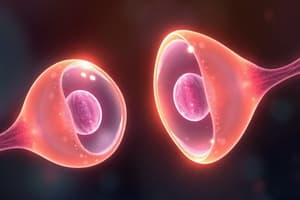Podcast
Questions and Answers
What is the primary purpose of meiosis in organisms?
What is the primary purpose of meiosis in organisms?
- To produce diploid gametes
- To ensure genetic variation in offspring (correct)
- To create zygotes directly
- To facilitate asexual reproduction
During fertilization, where does the sperm usually meet the egg?
During fertilization, where does the sperm usually meet the egg?
- In the kidneys
- In the male reproductive tract
- In the ovary
- In the fallopian tubes (correct)
What is formed immediately after fertilization takes place?
What is formed immediately after fertilization takes place?
- A placenta
- A zygote (correct)
- A gamete
- An embryo
Why are gametes considered essential in sexual reproduction?
Why are gametes considered essential in sexual reproduction?
In which process does the zygote develop into a multicellular structure?
In which process does the zygote develop into a multicellular structure?
What role do gametes play in the perpetuation of species?
What role do gametes play in the perpetuation of species?
What is the main role of gametes in sexual reproduction?
What is the main role of gametes in sexual reproduction?
Which term describes haploid cells containing half the number of chromosomes found in somatic cells?
Which term describes haploid cells containing half the number of chromosomes found in somatic cells?
What is the main difference between sperm and egg cells?
What is the main difference between sperm and egg cells?
Which organelle in sperm provides energy for their journey through the female reproductive tract?
Which organelle in sperm provides energy for their journey through the female reproductive tract?
What is the role of egg cells in sexual reproduction?
What is the role of egg cells in sexual reproduction?
Why are gametes essential for fertilization to occur?
Why are gametes essential for fertilization to occur?
Flashcards are hidden until you start studying
Study Notes
Understanding Sexual Reproduction and Its Components: Gametes
In the realm of life's processes, sexual reproduction is an intricate dance between two organisms, resulting in the formation of offspring with unique, genetically diverse traits. This cycle is driven by specialized cells known as gametes, which play a central role in the story of procreation.
Gametes: The Building Blocks of Sexual Reproduction
Gametes are haploid cells, meaning they contain half the number of chromosomes found in somatic (body) cells of an organism. There are two types of gametes: sperm (spermatozoa) in males and eggs (ova) or egg cells in females. These gametes fuse together during fertilization, creating a new, diploid organism.
Sperm
Sperm are microscopic, motile cells produced by male organisms. They are packed with mitochondria to provide energy for their arduous journey through the female reproductive tract. Sperm cells contain a single, streamlined nucleus and a long, whip-like tail that propels the sperm to find the egg.
Egg
Egg cells are larger, non-motile cells produced by female organisms. They have a protective membrane enclosing a single, round nucleus containing half the total number of chromosomes of the organism. Egg cells are also filled with nutrients to support the developing embryo after fertilization.
The Sexual Reproduction Process
The process of sexual reproduction involves several steps, and gametes play a pivotal role in each phase.
-
Meiosis: Female and male organisms produce haploid gametes through a process called meiosis, which involves cell division and chromosome separation. This ensures genetic variation in the resulting offspring.
-
Fertilization: After the gametes are released, sperm and egg cells meet in the female reproductive tract. Sperm move through the cervix, uterus, and fallopian tubes in search of the egg. Once a sperm cell penetrates the egg's protective membrane, fertilization occurs, forming a zygote.
-
Embryonic Development: The zygote develops into an embryo, which grows and divides, forming a multicellular structure. The embryo undergoes several stages, culminating in the birth of a new organism.
Conclusion
Gametes are the fundamental building blocks of sexual reproduction, ensuring genetic variability and contributing to the formation of new life. Their unique characteristics and roles in the sexual reproduction process make them an essential element in the cycle of life and the perpetuation of species. Understanding gametes and their role in sexual reproduction offers a fascinating glimpse at the intricate web of life and the diverse strategies employed by organisms to pass their genes to future generations.
Studying That Suits You
Use AI to generate personalized quizzes and flashcards to suit your learning preferences.




